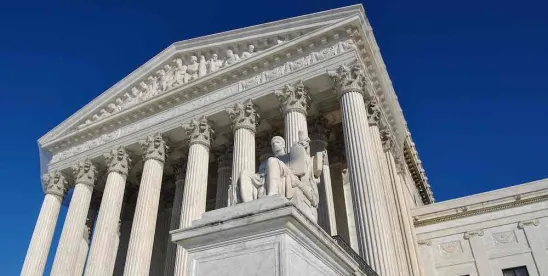The U.S. Supreme Court’s recent decision in Sheetz v. County of El Dorado may have a profound impact on inclusionary zoning ordinances and bylaws in Massachusetts. I suspect few of those regulations – if challenged – will pass constitutional muster under what’s now a quartet of crucial, related Supreme Court (SCOTUS) decisions: Nollan v. California Coastal Commission (1987), Dolan v. City of Tigard (1994), Koontz v. St. Johns River Water Management District (2013), and Sheetz. For purposes of this post, “inclusionary zoning” means zoning regulations that require new residential developments to include a certain number or percentage of affordable housing units, or a payment of money in lieu of providing such housing.
First, some background.
In Nollan the plaintiffs applied for a permit to expand their Southern California beach bungalow. The defendant commission, applying state law, conditioned issuance of the permit on the Nollans’ granting a public access easement over part of their property. SCOTUS held that to satisfy the Fifth Amendment’s prohibition on takings of private property for public use without just compensation, conditions in land-use permits must have a direct and “essential nexus” to the impact of the proposed project; an indirect connection will not suffice.
In Dolan the plaintiff sought a permit to expand her business and parking lot in Tigard, Oregon. The defendant city, applying its municipal code, conditioned issuance of the permit on Dolan dedicating part of her property (about 10%) for use as a bike path and to improve the municipal storm drain system. SCOTUS held that for land-use conditions to be constitutional, the government must make “an individualized determination that the required dedication is related both in nature and extent [emphasis added] to the impact of the proposed development.” The Court held that, in addition to the “essential nexus” required by Nollan, there must be a “rough proportionality” between the conditions imposed and the development’s expected impacts.
In Koontz the plaintiff applied for a permit to develop about a quarter of his vacant 14.2-acre parcel in central Florida. In negotiations with the defendant water district Koontz offered to subject the remaining three quarters of his land to a permanent conservation easement. The water district deemed this insufficient and demanded that Koontz also pay more than $150,000 for improvements to public land miles away from his land. SCOTUS rejected the water district’s arguments that the “essential nexus” and “rough proportionality” tests of Nollan and Dolan (1) don’t apply where the government denies a permit due to the applicant’s refusal to accede to the demanded concessions, and (2) apply only to actual takings of real property, not failed attempts to extract money from an applicant in exchange for a permit. As to the first argument, the Court observed that such a rule “would enable the government to evade the limitations of Nollan and Dolan simply by phrasing its demands for property as conditions precedent to permit approval.” As to the second argument, the Court stated, “Even if [the water district] would have been entirely within its rights in denying the permit for some other reason, that greater authority does not imply a lesser power to condition permit approval on [plaintiff’s] forfeiture of his constitutional rights.” [Sadly, Koontz didn’t live long enough to enjoy his SCOTUS victory, which was the culmination of a 19-year legal odyssey.]
Together, the rules established by Nollan, Dolan, and Koontz have come to be known as the “unconstitutional conditions” doctrine, a distinct species within the category of regulatory takings.
That brings us to Sheetz, where the plaintiff sought a building permit to install a manufactured home on a small vacant lot in El Dorado County, California, where he and his wife planned to retire. The defendant county refused to grant the permit unless Sheetz paid a “traffic impact fee” of $23,420. The amount of the fee was based not on any individualized assessment of the traffic impacts of Sheetz’s project, but rather on a rate schedule contained in a “General Plan” that the county had enacted. The schedule took into account various types of developments and their locations within the county. Sheetz paid the fee under protest, got his permit, and sued the county, first in state court and then in federal court. All the lower courts ruled against Sheetz on the ground that the unconstitutional conditions doctrine applies only to ad hoc land-use conditions imposed by administrative agencies on individual applicants – not to generally applicable legislative enactment such as the county’s General Plan. In its April 12, 2024 decision SCOTUS reversed, holding that there is no “legislative exception” to the unconstitutional conditions doctrine. Quoting its 2010 decision in Stop the Beach Renourishment, Inc. v. Florida Dept. of Environmental Protection, the Court observed, “The Constitution provides ‘no textual justification for saying that the existence or the scope of a State’s power to expropriate private property without just compensation varies according to the branch of government effecting the expropriation.’”
Strikingly, in contrast to Nollan, Dolan, and Koontz, all of which were 5-4 decisions, Sheetz was unanimous: all nine justices signed on to the opinion authored by Justice Barrett. There were three concurrences that largely discussed issues the Court was not deciding. The most important concurrence was one authored by Justice Kavanaugh and joined by Justices Kagan and Jackson, in which the concurring justices stated: “Importantly . . . today’s decision does not address or prohibit the common government practice of imposing permit conditions, such as impact fees, on new developments through reasonable formulas or schedules that assess the impact of classes of development rather than the impact of specific parcels of property. Moreover, as is apparent from the fact that today’s decision expressly leaves the question open, no prior decision of this Court has addressed or prohibited that longstanding government practice.”
Many Massachusetts cities and towns have inclusionary zoning regulations that apply to all developments creating some minimum number of new building lots, and purport to require that some minimum number or percentage of the newly-created lots be set aside for housing that meets a certain standard of affordability. While these regulations tend to be lengthy and complex, in essence they say (for example), “In developments involving the division of land into eight or more building lots, at least 12% of such building lots shall be restricted to use for affordable housing. Affordable housing shall mean a dwelling unit available at a cost of no more than 30% of the gross household income of households at or below 80% of the [ ] County median income as reported by the U.S. Department of Housing and Urban Development.” In most cases, these regulations were adopted without any meaningful analysis of the impact of a market-rate residential development of a particular size on the availability or cost of housing in that particular community, and the required percentages were chosen arbitrarily. In some municipalities the affordable housing requirement is mandatory; in others the developer is allowed to “buy out” its obligation by making a prescribed (often hefty) financial contribution to the local affordable housing trust. While well-intentioned, such regulations are likely unconstitutional because they fail the “essential nexus” and “rough proportionality” tests of Nollan and Dolan, which apply to exactions of both real property and money per Koontz, and to legislative enactments (such as local zoning ordinances and bylaws) per Sheetz. Such regulations may be invalid for the additional reason that they impermissibly burden the developer’s rights under the state Subdivision Control Law, under which subdivisions can’t be subjected to requirements not directly related to the narrow purposes of that law, which are to protect public health and safety by ensuring adequate access and utility service to the newly-created lots. Two recent decisions invalidating inclusionary housing regulations on this basis are here and here.
Besides being of dubious constitutionality, from a policy standpoint inclusionary zoning regulations haven’t significantly increased the supply of affordable housing. Some studies suggest that by increasing developers’ costs and reducing their profits, such regulations actually deter housing production, exacerbating the imbalance between supply and demand and increasing prices overall. Because inclusionary zoning represents an effort to solve a broad (and severe) socio-economic problem on the backs of the very actors – residential developers – who are in the best position to help, policymakers should focus on broader, more effective solutions.



 />i
/>i

